The story of ‘the three Dubs’ was recorded by Bill Fay, son of Daniel and nephew of the Moore brothers. The three men came from the same North inner-city area of Dublin, near Dorset Street.
Daniel Fay
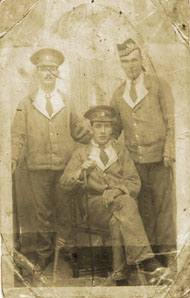
Daniel Fay is pictured here, standing on the left.
Daniel’s first job was as a porter in a grocery shop in Dorset Street, his second was porter/messenger in a butcher’s shop for a shilling a week. He had been working at the Customs House Docks when he enlisted in the 2nd Battalion of the Royal Dublin Fusiliers in 1908.
Married two years before the outbreak of the war, Daniel was fighting beside his young brother-in-law when James was killed in action near Ypres. Daniel was injured less than four months before the end of the war and received an Honourable Discharge. His Discharge Cerficate declared he was suffering from Melancholia, though he didn’t receive his small pension until 1923.
He was fortunate enough to be re-employed on the Docks and was able to support his family of seven children, several of whom continued the family military tradition.
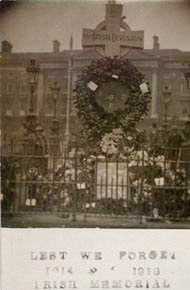
The Celtic Cross shown here is known as the ‘Ginchy Cross’ named after the village in France which the Irish Division took back from the Germans in September 1916.
It was made by the pioneers of the 16th (Irish) Division who were the 11th Hampshire Regiment,and erected from a ruined farmhouse in Ginchy. Today the same cross is held in a room at the War Memorial Gardens, Islandbridge. A similar cross stands in the village of Guillemont.
The Celtic Cross shown here is known as the ‘Ginchy Cross’ named after the village in France which the Irish Division took back from the Germans in September 1916.
It was made by the pioneers of the 16th (Irish) Division who were the 11th Hampshire Regiment,and erected from a ruined farmhouse in Ginchy. Today the same cross is held in a room at the War Memorial Gardens, Islandbridge. A similar cross stands in the village of Guillemont.
Bartholomew Moore
Known as Bartle, this Dub had one of the saddest fates of all. He enlisted in the 2nd Battalion of the Royal Dublin Fusiliers towards the end of 1912. Almost a year after the war, in October 1919, Bartle was given an Honourable Discharge on medical grounds. He was first sent to Belfast War Hospital and later transferred to a Dublin hospital. He spent the remaining thirty-eight years of his life in psychiatric care. Bartle is buried in Blackhorse Avenue Military Cemetery, Dublin. In accordance with convention, his headstone is cut away at the top corners to indicate that he did not die in action.
James Moore
It was the lock-out of 1913 that forced James Moore to enlist in the 2nd Battalion of the Royal Dublin Fusiliers when he had just turned 21. James was killed near Ypres on March 2nd, 1915, when fighting alongside his brother-in-law, Daniel Fay. It was eighty-three years before any member of his family managed to visit James’ grave at Prowse Point Military Cemetery, where his neices laid a wreath in November 1998. Another Royal Dublin Fusilier and native Dubliner, Private Christopher Rogers, is buried beside James. Christopher’s granddaughter and grandson also laid a wreath at his grave for the first time in November 1998.
Some of Daniel Fay’s Belongings
 He had served 4 years, 21 days with the Colours and 6 years, 102 days with the Special Reserve. He had joined up in April 1908. |
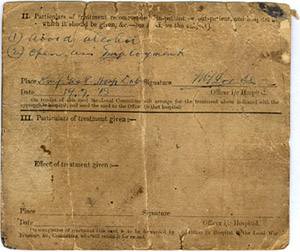 This was Daniel’s Treatment Card, which specifies that he should avoid alcohol and have ‘open air’ employment. The other side of this card identifies his condition as ‘Melancholia’. He was discharged from the King George V Hospital, Dublin on August 8th, 1918. |
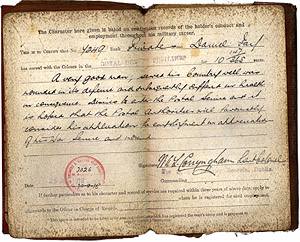 This is a Daniel’s character reference which states, ‘A very good man; served his Country well and was wounded in its defence.’ It is dated September 30, 1919. |
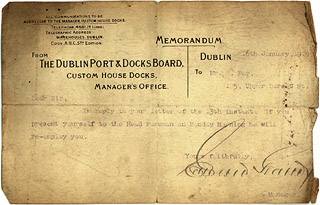 Three days after writing to the Dublin Port & Docks Board on January 13, 1919, this letter was sent to Daniel advising him to meet the Head Foreman the following Monday morning to be re-employed. |